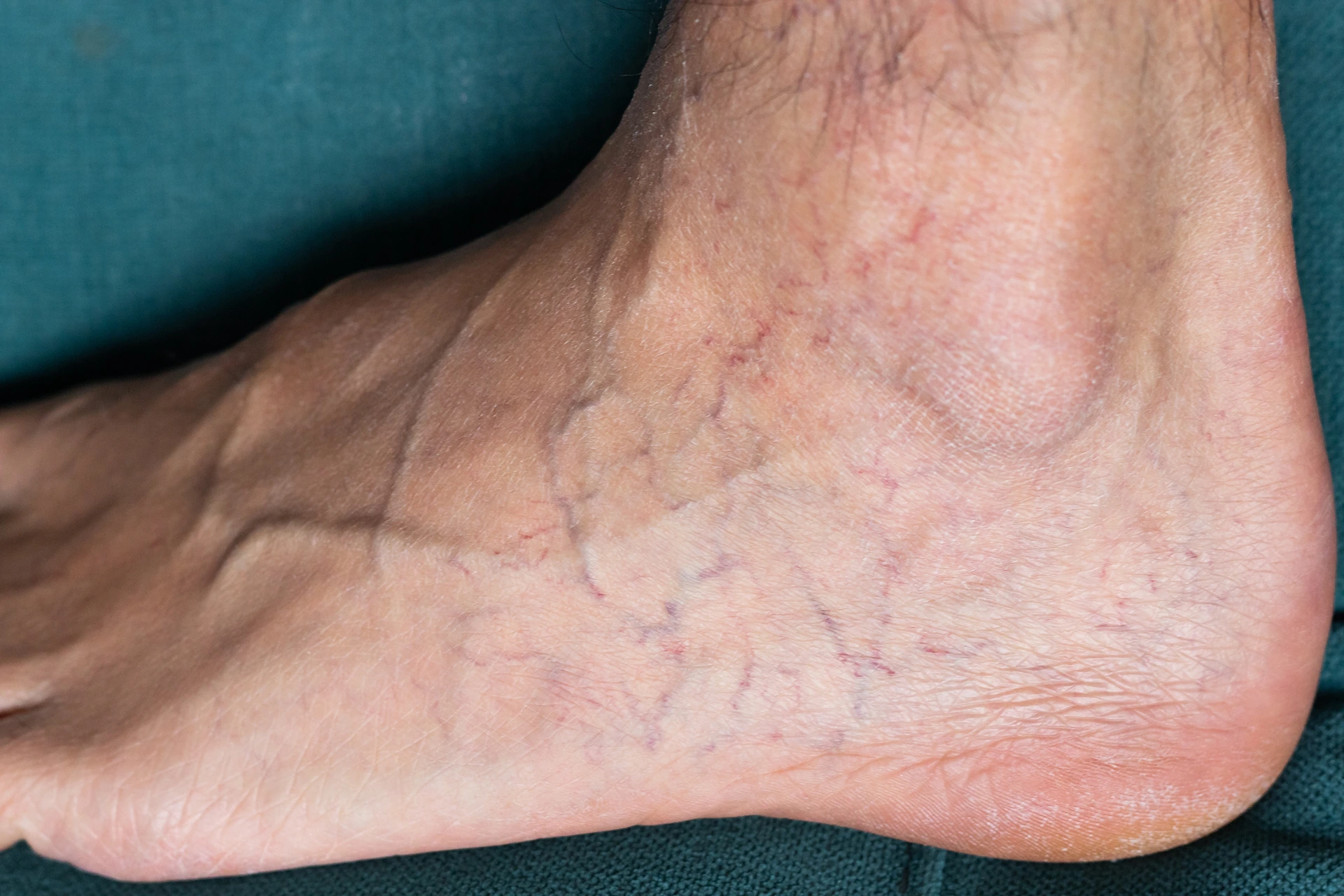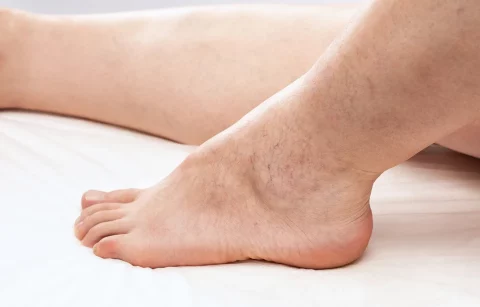Finding Relief From Those Creeping Spider Veins That Have Taken Up Residence on the Inner Ankles
Inner ankle spider veins themselves are not dangerous, but they can be a warning sign of underlying circulation problems that may need medical care if symptoms like leg pain and swelling develop. Seeking treatment for inner ankle spider veins can help prevent complications like blood clots or leg ulcers.
If you have noticed a creeping formation of thin spidery veins on the inner sides of your ankles, you’re not alone. Spider veins frequently develop in the lower legs, especially around the ankles and feet.
While these tangled tiny blood vessels may seem harmless, they can be a source of irritation or an indicator of problematic vein health.
Read on to learn what causes inner ankle spider veins, how to identify them, prevent them from worsening, and explore effective treatment options.
What Are Inner Ankle Spider Veins?

Spider veins are small, thin veins that lie close to the surface of the skin. They typically appear reddish, bluish, or purple and have a spider web-like branching shape. Spider veins on the ankle most frequently occur due to increased pressure in the veins caused by:
- Prolonged standing or sitting – Blood can pool in the veins of the lower legs when remaining in these stationary positions for long periods, leading to damaged valves and vessel walls.
- Wearing restrictive clothing or shoes – Tight clothing, socks, pants and especially high heels or narrow shoes can impair circulation, placing excess pressure on ankle veins.
- Being overweight – Carrying excess weight puts more pressure on the veins.
- Hormonal factors – Fluctuations during puberty, pregnancy, and menopause can affect vein strength.
- Genetics – Some people inherit a predisposition for weak vein valves or walls.
- Lifestyle habits – Lack of physical activity or movement can increase risk.
Spider veins may be fed from blood that overflows from underlying unhealthy surface veins, indicating the presence of more serious problems that require medical diagnosis and care.
How to Tell If You Have Spider Veins on the Inner Ankles
Identifying spider veins early is important to get proper treatment and prevent complications. There are several key ways to recognize spider veins developing around the inner ankles.
| Visible signs | Thin, web-like bluish, reddish or purple veins visible under the surface of the skin around the inner ankles |
| Symptoms | Itching, burning sensations, discomfort, or aching in the ankles which can signal poor circulation or blood pooling |
| Changes in appearance | Worsening pain, increased swelling, warmth, or brightening color of existing veins can indicate problematic vein health |
The most definitive way to check for spider veins is to consult a vein specialist for a visual examination and potential vascular ultrasound imaging to fully evaluate vein health.
Don’t ignore persistent or worsening spider veins on the ankles. Seek medical advice to address potential underlying problems. Consult with the experts from The Vein Center Doctor
Are Spider Veins on the Inner Ankles Dangerous?
Spider veins themselves are generally not medically dangerous or a direct health risk. They are a cosmetic concern rather than a medical one in most cases. However, spider veins can potentially indicate underlying circulation problems or chronic venous insufficiency, which may require treatment if left unaddressed.
Some potential risks and complications that can develop from untreated spider veins and venous insufficiency include:
- Worsening achiness, throbbing, cramping, swelling, numbness, tingling, restlessness, fatigue or heaviness in the lower legs and ankles. This is a sign of chronic venous insufficiency.
- Progression to larger, rope-like varicose veins. Spider veins can sometimes expand into varicose veins over time.
- Venous eczema – a rash, itchy, inflamed skin condition resulting from poor blood flow in the veins.
- Increased risk of superficial venous thrombosis – blood clots forming in surface veins, causing pain and swelling.
- Leg ulcers – open, painful sores that develop on the ankles and lower legs from chronic poor circulation.
- Permanent skin discoloration and texture changes around the ankles.
- Impaired wound healing in the lower legs.
- Rarely, phlebitis – inflammation of a vein.
While spider veins aren’t directly perilous, their presence can signal more problematic vein disorders. Seeking appropriate medical care is crucial for preventing long-term complications and discomfort.
Preventing Inner Ankle Spider Veins At Home

Some proactive self-care techniques to help prevent inner ankle spider veins include:
- Wearing compression socks to improve circulation.
- Maintaining a healthy weight to avoid pressure on leg veins.
- Doing regular exercise like walking, swimming and leg raises.
- Avoiding tight clothing and shoes around the ankles.
- Keeping legs elevated while sitting or sleeping to improve blood flow.
- Using topical remedies like apple cider vinegar to boost circulation.
However, once spider veins have already developed, most home remedies provide only minor symptom relief. More intensive medical procedures are typically required to fully eliminate existing spider veins on the ankles.
Why Home Remedies Aren’t Enough
While home remedies temporarily minimize the appearance of spider veins, professional medical procedures are required to fully and permanently eliminate existing superficial varicose veins on the ankles.
Spider veins that have already formed on the inner ankles will not disappear without treatment. While spider veins that develop during pregnancy may fade after giving birth, veins damaged by long-term pressure, circulatory dysfunction and genetic weaknesses will persist.
Seeking medical treatment is necessary for removing established spider veins on the ankles.
Experience lasting results with specialized treatments from The Vein Center Doctor. Say goodbye to stubborn spider veins on your ankles with our expert care.
Medical Treatments for Inner Ankle Spider Veins
There are several advanced minimally invasive treatments provided by The Vein Specialists to eliminate inner ankle spider veins, including:
Sclerotherapy
One of the most widely used methods, this involves injecting a special sclerosing solution directly into the damaged vein. The solution irritates the vessel lining, causing inflammation that makes the vein collapse and seal shut.
The now closed-off vein is eventually absorbed into the body and fades away. With the problematic vein treated, blood flow is redirected through healthier veins. Multiple sessions are sometimes needed for complete results. Sclerotherapy is a safe, effective treatment that requires no anesthesia or downtime.
VenaSeal
VenaSeal is an innovative procedure that uses an FDA-cleared medical adhesive to seal off the diseased vein. Your doctor will first use ultrasound imaging to guide a catheter into the damaged vein. The adhesive is then injected into the vein, bonding to the vessel walls.
This seals the vein closed to restore normal blood flow through nearby healthy veins. The treatment takes only 15-20 minutes in your doctor’s office with no need for compression stockings afterward. Patients can resume regular activity right away.
Compression Therapy
Prescribed medical-grade compression stockings are often utilized along with other treatments to improve results and prevent recurrence of spider veins. The gentle squeezing pressure applied by compression garments helps move blood up the legs, improves circulation, reduces pain and swelling, and can speed healing after procedures.
Compression therapy may also provide relief when used alone. Your vein specialist can recommend the optimal compression level and usage instructions.
Radiofrequency Ablation
Also known as RFA, this procedure uses targeted thermal energy to seal spider veins shut. A thin catheter will be inserted into the damaged vein and positioned under ultrasound guidance. Controlled radiofrequency energy is then delivered through the catheter as it is gradually pulled back, heating and collapsing the vein.
The vein seals shut to redirect blood flow to healthy veins. This minimally invasive treatment is done in the doctor’s office and typically requires no downtime. Mild bruising or tenderness may occur temporarily.
With an expert evaluation, your vein doctor can determine the best treatment approach for your individual case. Procedures like sclerotherapy and VenaSeal can often effectively eliminate irritating ankle spider veins in a single brief, non-invasive treatment with little discomfort. Contact us today to learn more about your options.
Get Professional Treatment From Vein Specialists

If inner ankle spider veins are bothering you, don’t hesitate to seek expert vein care. The Vein Center Doctor offers cutting-edge diagnosis and treatments to eliminate spider veins and improve comfort. Book a consultation with The Vein Center Doctor today or call us at 1-862-500-4747 to start resolving those frustrating spider veins on your ankles for good.







